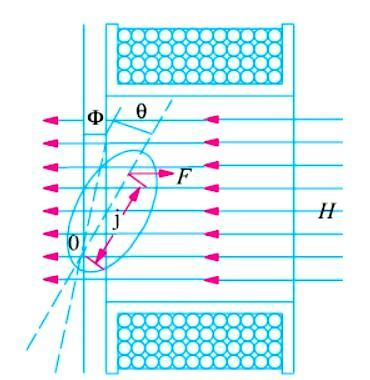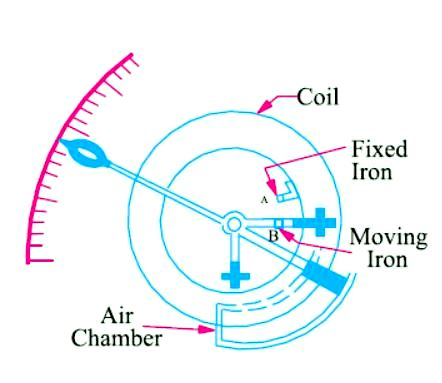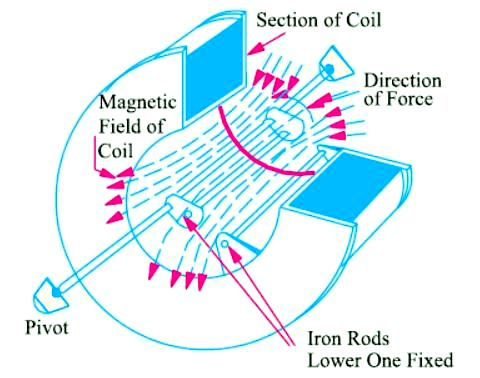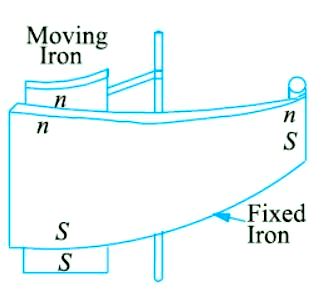Moving Iron Instruments
There are two basic forms of Moving Iron Instruments i.e. the attraction type and the repulsion type. The operation of the attraction type depends on the attraction of a single piece of soft iron into a magnetic field and that of repulsion type depends on the repulsion of two adjacent pieces of iron magnetised by the same magnetic field. For both types of these instruments, the necessary magnetic field is produced by the ampere-turns of a current-carrying coil.
In case the instrument is to be used as an ammeter, the coil has comparatively fewer turns of thick wire so that the ammeter has low resistance because it is connected in series with the circuit. In case it is to be used as a voltmeter, the coil has high impedance so as to draw as small a current as possible since it is connected in parallel with the circuit. As the current through the coil is small, it has large number of turns in order to produce sufficient ampere-turns.

Attraction Type Moving Iron Instruments:
The basic working principle of an attraction- type moving-iron instrument is illustrated in Figure (A). It is well-known that if a piece of an un-magnetised soft iron is brought up near either of the two ends of a current-carrying coil, it would be attracted into the coil in the same way as it would be attracted by the pole of a bar magnet. Hence, if we pivot an oval-shaped disc of soft iron on a spindle between bearings near the coil (Figure A), the iron disc will swing into the coil when the latter has an electric current passing through it. As the field strength would be strongest at the center of the coil, the oval shaped iron disc is pivoted in such a way that the greatest bulk of iron moves into the centre of the coil. If a pointer is fixed to the spindle carrying the disc, then the passage of current through the coil will cause the pointer to deflect. The amount of deflection produced would be greater when the current producing the magnetic field is greater. Another point worth noting is that whatever the direction of current through the coil, the iron disc would always be magnetised in such a way that it is pulled inwards. Hence, such instruments can be used both for direct as well as alternating currents.
A sectional view of the actual instrument is shown in Figure (B). When the current to be measured is passed through the coil or solenoid, a magnetic field is produced, which attracts the eccentrically mounted disc inwards, thereby deflecting the pointer, which moves over a calibrated scale.

AdBlock-2

Deflecting Torque
Let the axis of the iron disc, when in zero position, subtend an angle of φ with a direction perpendicular to the direction of the field H produced by the coil. Let the deflection produced be θ corresponding to a current I through the coil. The magnetisation of iron disc is proportional to the component of H acting along the axis of the disc i.e. proportional to
H cos [90 − (φ + θ)] or H sin (θ + φ).
The force F pulling the disc inwards is proportional to MH or H2sin (θ + φ). If the permeability of iron is assumed constant, then, H ∝ I. Hence, F ∝ I2sin (θ + φ). If this force acted at a distance of l from the pivot of the rotating disc, then deflecting torque Td = Fl cos (θ + φ). Putting the value of F,
we get
Td ∝ I2sin (θ + φ) × l cos (θ + φ) ∝ I2 sin2(θ + φ) = KI2 sin 2 (θ + φ) …sin l is constant
If spring-control is used, then controlling torque Tc = K′ θ
In the steady position of deflection, Td = Tc
∴ KI2 sin2(θ + φ) = K′ θ ; Hence θ ∝ I2
If A.C. is used, then θ ∝ I2 r.m.s.
However, if gravity-control is used, then Tc = K1sin θ
∴ KI2 sin2(θ + φ) = K1sin θ
∴ sin θ α I2 sin2(θ + φ)
In both cases, the scales would be uneven.
Damping
As shown, air-friction damping is provided, the actual arrangement being a light piston moving in an air-chamber.
Repulsion Type Moving Iron Instruments
The sectional view and cut-away view of such an instrument are shown in Figure (D) and Figure (E). It consists of a fixed coil inside which are placed two soft-iron rods (or bars) A and B parallel to one another and along the axis of the coil. One of them i.e. A is fixed and the other B which is movable carries a pointer that moves over a calibrated scale. When the current to be measured is passed through the fixed coil, it sets up its own magnetic field which magnetises the two rods similarly i.e. the adjacent points on the lengths of the rods will have the same magnetic polarity. Hence, they repel each other with the result that the pointer is deflected against the controlling torque of a spring or gravity. The force of repulsion is approximately proportional to the square of the current passing through the coil. Moreover, whatever may be the direction of the current through the coil, the two rods will be magnetised similarly and hence will repel each other.


In order to achieve uniformity of scale, two tongue-shaped strips of iron are used instead of two rods. As shown in Figure (F), the fixed iron consists of a tongue-shaped sheet iron bent into a cylindrical form, the moving iron also consists of another sheet of iron and is so mounted as to move parallel to the fixed iron and towards its narrower end [Figure (G)].
Deflecting Torque
The deflecting torque is due to the repulsive force between the two similarly magnetised iron rods or sheets.


Instantaneous torque ∝ repulsive force ∝ m1m2 ………product of pole strengths
Since pole strength are proportional to the magnetising force H of the coil,
∴ instantaneous torque ∝ H2
Since H itself is proportional to current (assuming constant permeability) passing through the coil,
∴ instantaneous torque ∝ I2
Hence, the deflecting torque, which is proportional to the mean torque is, in effect, proportional to the mean value of I2. Therefore, when used on a.c. circuits, the instrument reads the r.m.s. value of current.
Scales of such instruments are uneven if rods are used and uniform if suitable-shaped pieces of iron sheet are used.
The instrument is either gravity-controlled or as in modern makes, is spring-controlled. Damping is pneumatic, eddy current damping cannot be employed because the presence of a permanent magnet required for such a purpose would affect the deflection and hence, the reading of the instrument.
Since the polarity of both iron rods reverses simultaneously, the instrument can be used both for A.C. and D.C. circuits i.e. instrument belongs to the unpolarized class.
Sources of Error
There are two types of possible errors in such instruments, firstly, those which occur both in a.c. and d.c. work and secondly, those which occur in a.c. work alone.
(a) Errors with both d.c. and a.c. work
(i) Error due to hysteresis. Because of hysteresis in the iron parts of the moving system, readings are higher for descending values but lower for ascending values.
The hysteresis error is almost completely eliminated by using Mumetal or Perm-alloy, which have negligible hysteresis loss.
(ii) Error due to stray fields. Unless shielded effectively from the effects of stray external fields, it will give wrong readings. Magnetic shielding of the working parts is obtained by using a
covering case of cast-rion.
(b) Errors with a.c. work only
Changes of frequency produce
(i) change in the impedance of the coil and (ii) change in the magnitude of the eddy currents.
The increase in impedance of the coil with increase in the frequency of the alternating current is of importance in voltmeters. For frequencies higher than the one used for calibration, the instrument gives lower values. However, this error can be removed by connecting a capacitor of suitable value in parallel with the swamp resistance R of the instrument. It can be shown that the impedance of the whole circuit of the instrument becomes independent of frequency if C = L/R2 where C is the capacitance of the capacitor.
Advantages and Disadvantages of Moving Iron Instruments
Such instruments are cheap and robust, give a reliable service and can be used both on A.C. and D.C. circuits, although they cannot be calibrated with a high degree of precision with D.C. on account of the effect of hysteresis in the iron rods or vanes. Hence, they are usually calibrated by comparison with an alternating current standard.
Read article – Units of Resistivity
Visit NCERTplanet.com for NCERT solutions and Textbook downloads



